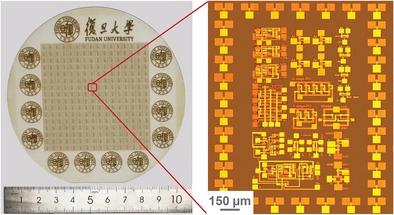当前位置:
X-MOL 学术
›
Adv. Mater.
›
论文详情
Our official English website, www.x-mol.net, welcomes your
feedback! (Note: you will need to create a separate account there.)
Pass-Transistor Logic Circuits Based on Wafer-Scale 2D Semiconductors
Advanced Materials ( IF 27.4 ) Pub Date : 2022-06-21 , DOI: 10.1002/adma.202202472 Xinyu Wang 1 , Xinyu Chen 1 , Jingyi Ma 1 , Saifei Gou 1 , Xiaojiao Guo 1 , Ling Tong 1 , Junqiang Zhu 2 , Yin Xia 1 , Die Wang 1 , Chuming Sheng 1 , Honglei Chen 1 , Zhengzong Sun 1 , Shunli Ma 1 , Antoine Riaud 1 , Zihan Xu 3 , Chunxiao Cong 2 , Zhijun Qiu 2 , Peng Zhou 1 , Yufeng Xie 1 , Lifeng Bian 4 , Wenzhong Bao 1
Advanced Materials ( IF 27.4 ) Pub Date : 2022-06-21 , DOI: 10.1002/adma.202202472 Xinyu Wang 1 , Xinyu Chen 1 , Jingyi Ma 1 , Saifei Gou 1 , Xiaojiao Guo 1 , Ling Tong 1 , Junqiang Zhu 2 , Yin Xia 1 , Die Wang 1 , Chuming Sheng 1 , Honglei Chen 1 , Zhengzong Sun 1 , Shunli Ma 1 , Antoine Riaud 1 , Zihan Xu 3 , Chunxiao Cong 2 , Zhijun Qiu 2 , Peng Zhou 1 , Yufeng Xie 1 , Lifeng Bian 4 , Wenzhong Bao 1
Affiliation

|
2D semiconductors, such as molybdenum disulfide (MoS2), have attracted tremendous attention in constructing advanced monolithic integrated circuits (ICs) for future flexible and energy-efficient electronics. However, the development of large-scale ICs based on 2D materials is still in its early stage, mainly due to the non-uniformity of the individual devices and little investigation of device and circuit-level optimization. Herein, a 4-inch high-quality monolayer MoS2 film is successfully synthesized, which is then used to fabricate top-gated (TG) MoS2 field-effect transistors with wafer-scale uniformity. Some basic circuits such as static random access memory and ring oscillators are examined. A pass-transistor logic configuration based on pseudo-NMOS is then employed to design more complex MoS2 logic circuits, which are successfully fabricated with proper logic functions tested. These preliminary integration efforts show the promising potential of wafer-scale 2D semiconductors for application in complex ICs.
中文翻译:

基于晶圆级二维半导体的传输晶体管逻辑电路
二维半导体,例如二硫化钼 (MoS 2 ),在构建用于未来灵活且节能的电子产品的先进单片集成电路 (IC) 方面引起了极大的关注。然而,基于二维材料的大规模 IC 的开发仍处于早期阶段,主要是由于单个器件的不均匀性以及对器件和电路级优化的研究很少。在此,成功合成了 4 英寸高质量单层 MoS 2薄膜,然后将其用于制造顶栅(TG)MoS 2具有晶圆级均匀性的场效应晶体管。检查了一些基本电路,例如静态随机存取存储器和环形振荡器。然后采用基于伪 NMOS 的传输晶体管逻辑配置来设计更复杂的 MoS 2逻辑电路,这些电路通过适当的逻辑功能测试成功制造。这些初步的集成工作显示了晶圆级二维半导体在复杂 IC 中应用的巨大潜力。
更新日期:2022-06-21
中文翻译:

基于晶圆级二维半导体的传输晶体管逻辑电路
二维半导体,例如二硫化钼 (MoS 2 ),在构建用于未来灵活且节能的电子产品的先进单片集成电路 (IC) 方面引起了极大的关注。然而,基于二维材料的大规模 IC 的开发仍处于早期阶段,主要是由于单个器件的不均匀性以及对器件和电路级优化的研究很少。在此,成功合成了 4 英寸高质量单层 MoS 2薄膜,然后将其用于制造顶栅(TG)MoS 2具有晶圆级均匀性的场效应晶体管。检查了一些基本电路,例如静态随机存取存储器和环形振荡器。然后采用基于伪 NMOS 的传输晶体管逻辑配置来设计更复杂的 MoS 2逻辑电路,这些电路通过适当的逻辑功能测试成功制造。这些初步的集成工作显示了晶圆级二维半导体在复杂 IC 中应用的巨大潜力。










































 京公网安备 11010802027423号
京公网安备 11010802027423号